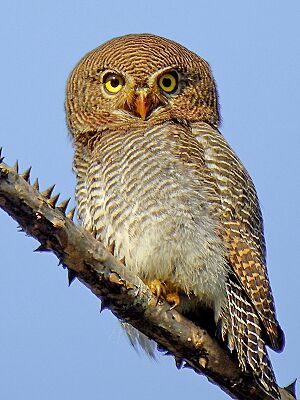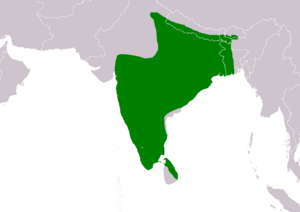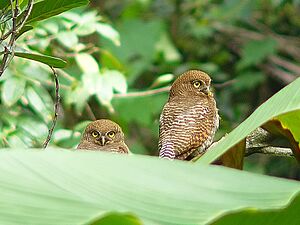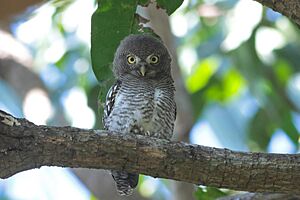Jungle owlet facts for kids
Quick facts for kids Jungle owlet |
|
|---|---|
 |
|
| Jungle owlet in Mangaon, Maharashtra | |
| Conservation status | |
| Scientific classification | |
| Genus: |
Glaucidium
|
| Species: |
radiatum
|
 |
|
| Range of G. radiatum Extant, resident | |
| Synonyms | |
|
Taenioglaux radiatum |
|
The jungle owlet (Glaucidium radiatum), also called the barred jungle owlet, is a small owl from the Indian Subcontinent. You can often spot them alone, in pairs, or in small groups. They are usually heard calling around sunrise and sunset. There are two main types, or subspecies, of jungle owlets. One type, found in the Western Ghats, is sometimes thought to be a completely different species.
Contents
What Jungle Owlets Look Like

This small owl has a round head. Its body is covered in thin stripes, or "bars." Unlike some owls, it doesn't have a clear "facial disk" (the flat, round part of an owl's face). Its wings are brownish, and its tail has thin white stripes.
There are two main types of jungle owlets:
- The first type is found in the plains of India and Sri Lanka.
- The second type, G. r. malabaricum, lives in the Western Ghats. This one has a shorter tail and more brown feathers on its head. Some scientists think this type might even be a separate species!
The feathers on the upper part of the owlet's body are dark black-brown with white stripes. Its wing feathers have white and reddish-brown patches. The main flight feathers are dark brown with pale chestnut stripes. The underside of the owlet is whitish or pale reddish-brown with black stripes. It has a white patch on its chin, upper chest, and belly. Its eyes are yellow, and its beak and feet are greenish with black claws.
In Sri Lanka, there's another owl called the chestnut-backed owlet (Glaucidium castanonotum). It used to be considered a type of jungle owlet. But now, it's known as its own species. The chestnut-backed owlet lives in wet forests, while the jungle owlet prefers drier forests.
Where Jungle Owlets Live
Jungle owlets can be found in many different places. These include scrub forests, which have small trees and bushes. They also live in deciduous forests, where trees lose their leaves in certain seasons. You can find them south of the Himalayas. They also live in some parts of the Himalayas, up to about 2,000 m (6,600 ft) high. Their range stretches from Dalhousie in the west to Bhutan in the east.
Daily Life and Habits
Jungle owlets are most active around sunrise and sunset. However, they are also known to call and fly during the day. Their call is easy to recognize. It sounds like a fast series of "prao..prao.prao-prao-prao." The sound gets louder, then softer, and then stops suddenly.
During the day, when they are resting, other birds might bother them. Birds like drongos, treepies, and sunbirds might "mob" them. This means they gather around and make loud noises to chase the owl away. Young owlets in their nests make "tick" calls. These calls sound a bit like the calls of a pale-billed flowerpecker.
Jungle owlets often rest inside hollow tree trunks. If they are disturbed, they might freeze. This makes them look like a part of the tree, helping them hide. Sometimes, they sit on wires or enjoy the morning sun. Then, they go back to their resting spot. They have even been seen catching small Phylloscopus warblers during the day. But they mostly hunt an hour before sunrise and after sunset.
What Jungle Owlets Eat
Jungle owlets eat a variety of things. Their diet includes:
- Insects
- Small birds
- Reptiles
- Rodents (like mice)
Reproduction and Life Cycle
The breeding season for jungle owlets in India is from March to May. They build their nests inside hollow trees. These nests are usually about 3 to 5 m (10 to 16 ft) above the ground. A female jungle owlet typically lays four eggs. However, the type found in the Western Ghats (G. r. malabaricum) usually lays three eggs.



